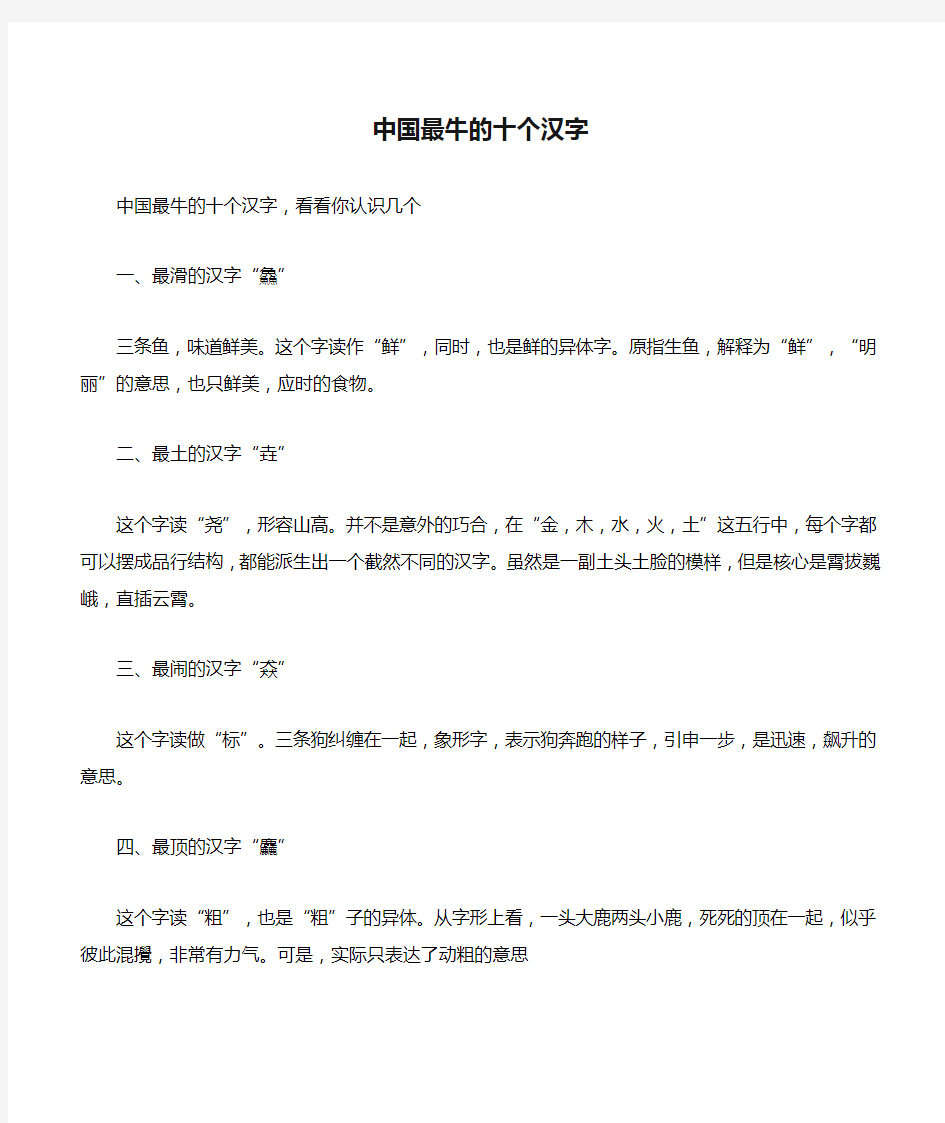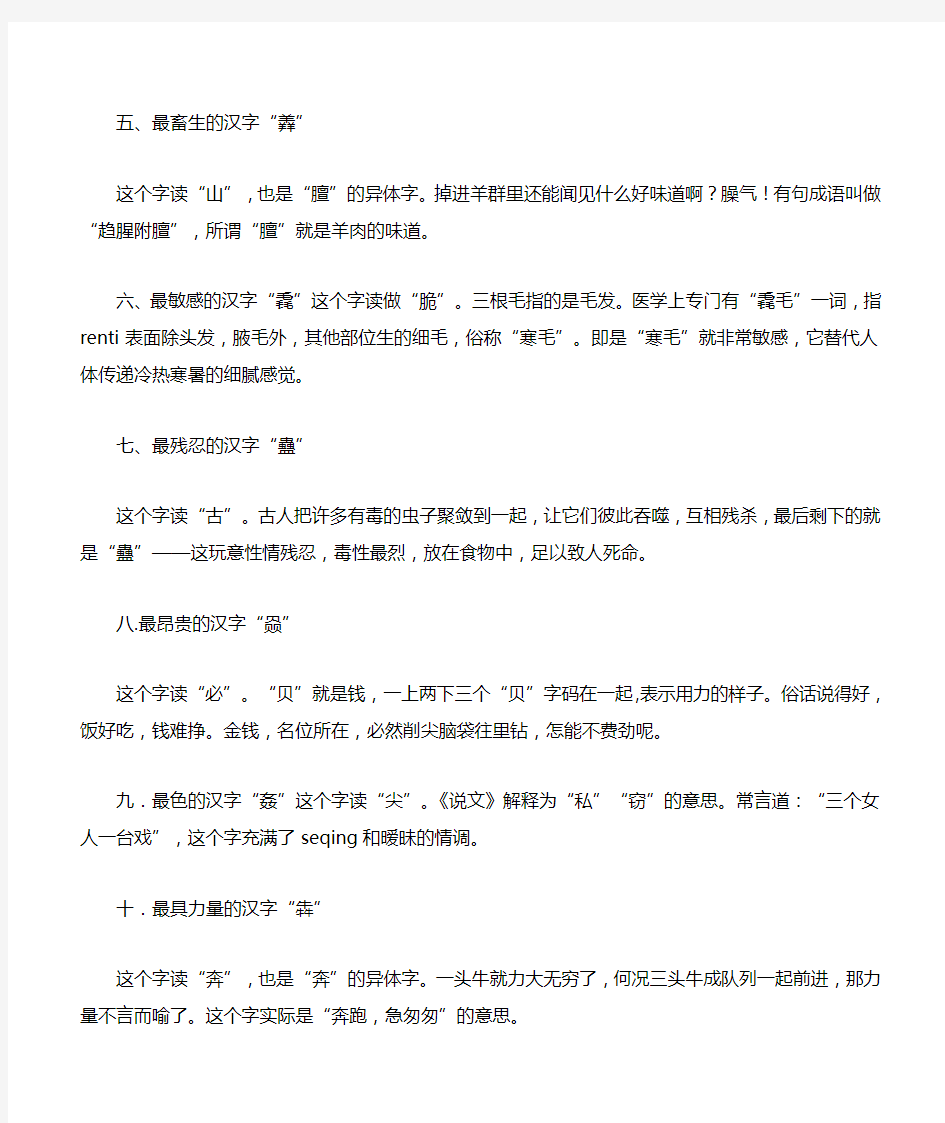中国最牛的十个汉字


中国最牛的十个汉字
中国最牛的十个汉字,看看你认识几个
一、最滑的汉字“鱻”
三条鱼,味道鲜美。这个字读作“鲜”,同时,也是鲜的异体字。原指生鱼,解释为“鲜”,“明丽”的意思,也只鲜美,应时的食物。
二、最土的汉字“垚”
这个字读“尧”,形容山高。并不是意外的巧合,在“金,木,水,火,土”这五行中,每个字都可以摆成品行结构,都能派生出一个截然不同的汉字。虽然是一副土头土脸的模样,但是核心是霄拔巍峨,直插云霄。
三、最闹的汉字“猋”
这个字读做“标”。三条狗纠缠在一起,象形字,表示狗奔跑的样子,引申一步,是迅速,飙升的意思。
四、最顶的汉字“麤”
这个字读“粗”,也是“粗”子的异体。从字形上看,一头大鹿两头小鹿,死死的顶在一起,似乎彼此混攪,非常有力气。可是,实际只表达了动粗的意思
五、最畜生的汉字“羴”
这个字读“山”,也是“膻”的异体字。掉进羊群里还能闻见什么好味道啊?臊气!有句成语叫做“趋腥附膻”,所谓“膻”就是羊肉的味道。
六、最敏感的汉字“毳”这个字读做“脆”。三根毛指的是毛发。医学上专门有“毳毛”一词,指renti表面除头发,腋毛外,其他部位生的细毛,俗称“寒毛”。即是“寒毛”就非常敏感,它替代人体传递冷热寒暑的细腻感觉。
七、最残忍的汉字“蠱”
这个字读“古”。古人把许多有毒的虫子聚敛到一起,让它们彼此吞噬,互相残杀,最后剩下的就是“蠱”——这玩意性情残忍,毒性最烈,放在食物中,足以致人死命。
八.最昂贵的汉字“赑”
这个字读“必”。“贝”就是钱,一上两下三个“贝”字码在一起,表示用力的样子。俗话说得好,饭好吃,钱难挣。金钱,名位所在,必然削尖脑袋往里钻,怎能不费劲呢。
九.最色的汉字“姦”这个字读“尖”。《说文》解释为“私”“窃”的意思。常言道:“三个女人一台戏”,这个字充满了seqing和暧昧的情调。
十.最具力量的汉字“犇”
这个字读“奔”,也是“奔”的异体字。一头牛就力大无穷了,何况三头牛成队列一起前进,那力量不言而喻了。这个字实际是“奔跑,急匆匆”的意思。
十一、最环保的汉字“森”
森,树木众多、繁密。独木不成林,三个木指木(树木)很多,就是森林了。有不少公司喜欢“木林森”这个名字,我好
像买过商标为“木林森”的皮鞋。“木林森”体现了汉字的神奇。
三个“字”摞一起念什么三个金念鑫(xīn)
三个水念淼(miǎo)
三个火念焱(yàn)
三个土念垚(yáo)
三个牛念犇(bēn)
三个手念掱(pá)
三个目念瞐(m?)
三个田念畾(lěi)
三个马念骉(biāo)
三个羊念羴(shān)
三个犬念猋(biāo)
三个鹿念麤(cū)
三个鱼念鱻(xiān)
三个贝念赑(bì)
三个力念劦(lie)
三个毛念毳(cuì)
三个耳念聶(nia)
三个车念轟(hōng)
三个直念矗(chù)
三个龙念龘(tà、dá)
三个原念厵(yuán)三个雷念靐(bìng)三个飞念飝(fēi)
三个刀念刕(lí)
三个又念叒(ru?)
三个士念壵(zhuàng)三个小念尛(m?)
三个子念孨(zhuǎn)三个止念歮(sa)
三个风念飍(xiū)
三个隼念雥(zá)
三个吉念嚞(zh?)
三个言念譶(tà)
三个舌念舙(qì)
三个香念馫(xīn)
三个泉念灥(xún)
三个心念惢(suǒ)
三个白念皛(xiǎo)
最奇特的十二个汉字
最奇特的十二个汉字 汉字中的“品型”结构酷似“金三角”,音、意、形都非常有趣。可惜,这些字绝大部分不常用,极为生僻,几乎变成了绝无仅有的“活化石”。 最土的汉字:垚 这个字读“遥”,山高的意思。并不是意外的巧合,在金、木、水、火、土这“五行”之中,每个字摆成品性结构,都能派生出另一个绝然不同的汉字 最色的汉字:姦 这个字读“奸”,也好似“奸”的异体字。《说文》里解释为“私”“盗”,《广雅》里说是“伪”的意思。常言道:“三个女人一台戏”,这个字充满了色情与暧昧的情调。 最滑的汉字:鱻 这个字读作“鲜”,同时,也是“鲜”的异体字。原指生鱼;抑或“新鲜”、“明丽”的意思;也指鲜美、应时的食物。 最闹的汉字:猋 这个字读“标”。字型很明显,三条狗纠缠在一起,表示狗群奔跑的样子;引申一步,便派生出迅速、飙升的意思。 最顶的汉字:麤 这个字读“粗”,也是汉字“粗”的异体字。从字型上看,一大两小三头鹿,死死地顶在一起,似乎彼此混搅,非常有力气,只表示动粗的意思。 最畜生的汉字:骉、羴、犇 “骉”,读“标”,字型很清楚,一匹马率领另外两匹,风驰电掣地奔跑。这个字恰恰是众马奔腾的意思。 “羴”,读“山”,也是“膻”的异体字。掉进羊群里还能闻着什么好味儿?臊气!有句成语叫做“趋腥附膻”吗?所谓“膻”,就是羊肉的气味。 “犇”,读作“奔”,也是“奔”的异体字。牛,本性温顺,三头牛碰面,也不至于太疯狂。这个字反倒是奔跑、急匆匆的意思。 最敏感的汉字:毳 这个字读作“崔”。还是指毛发,医学上专有“毳毛”一词,指人体表面生的细毛,俗称“寒毛”。既是“寒毛”就非常敏感,她替人体传递冷热寒暑的细腻感觉。 最恶毒的汉字:蠱
中国文化的英语介绍.
Chinese Dragon Dragon totem worship in China has been around for the last 8,000 years. The ancients in China considered the dragon (or loong) a fetish that combines animals including the fish, snake, horse and ox with cloud, thunder, lightning and other natural celestial phenomena. The Chinese dragon was formed in accordance with the multicultural fusion process of the Chinese nation. To the Chinese, the dragon signifies innovation and cohesion. 对龙图腾他的崇拜在中国大约已绵延了八千多年。中国龙是古人将鱼、蛇、马、牛等动物与云雾、雷电等自然天象集合而成的一种神物。中国龙的形成与中华民族的多元融合过程同步。在中国人的心目中,龙具有振奋腾飞、开拓变化的寓意和团结凝聚的精神。Dumplings Dumplings are one of the Chinese people’s favorite traditional dishes. According to an ancient Chinese legend, dumplings were first made by the medical saint---Zhang Zhongjing. There are three steps involved in making dumplings: 1) make dumpling wrappers out of dumpling flour; 2) prepare the dumpling stuffing; 3) make dumplings and boil them. With thin and elastic dough skin, fresh and tender stuffing, delicious taste, and unique shapes, dumplings are worth eating hundreds of times. There’s an old saying that claims, “Nothing could be more delicious than dumplings”. During the Spring Festival and other holidays, or when treating relatives and friends, Chinese people like to follow the auspicious custom of eating dumplings. To Chinese people who show high reverence for family love, having dumplings at the moment the old year is replaced by the new is an essential part of bidding farewell to the old and ushering in the new year. 饺子是深受中国人民喜爱的传统食品。相传为古代医圣张仲景发明。饺子的制作是包括:1)擀皮、2)备馅、3)包馅水煮三个步骤。其特点是皮薄馅嫩,味道鲜美,形状独特,百食不厌。民间有“好吃不过饺子”的俗语。中国人接亲待客、逢年过节都有包饺子吃的习俗,寓意吉利。对崇尚亲情的中国人来说,“更岁交子”吃饺子,更是欢度除夕、辞旧迎新必不可少的内容。 Acupuncture Acupuncture is an important part of traditional Chinese medicine (TCM). In accordance with the “main and collateral channels”theory in TCM, the purpose of acupuncture is to dredge the channel and regulate qi and blood, so as to keep the body’s yin and yang balanced and achieve reconciliation between the internal organs. It features in traditional Chinese medicine that “internal diseases are to be treated with external therapy”. The main therapy of acupuncture involves using needles to pierce certain acupoints of the patient’s body, or adopting moxibustion to stimulate the patient’s acupoints so as to stimulate the channels and relieve pain. With its unique advantages, acupuncture has been handed down generation after generation and has now spread all over the world. Nowadays, acupuncture, along with Chinese food, kung fu (otherwise known as Chinese martial arts), and traditional Chinese medicine, has been internationally hailed as one of the “four new national treasures.” 针灸是中医学的重要组成部分。按照中医的经络理论,针灸疗法主要是通过疏通经络、调和气血,来达到阴阳归于平衡,使脏腑趋于调和之目的。其特点是“内病外治”。主要疗法是用针刺入病人身体的一定穴位,或用艾火的温热刺激烧灼病人的穴位,以达到刺激经络。治疗病痛的目的。针灸以其独特的优势,流传至今并传播到了世界,与中餐、功夫、中药一起被海外誉为中国的“新四大国粹”。 Chinese Kung Fu Chinese kung fu, or Chinese martial arts, carries traditional Chinese culture in abundance. It is a
有关中国的特色的英语单词
用流利的英语介绍中国的特色 1. 元宵节:Lantern Festival 2. 刺绣:embroidery 3. 重阳节:Double-Ninth Festival 4. 清明节:Tomb sweeping day 5. 剪纸:Paper Cutting 6. 书法:Calligraphy 7. 对联:(Spring Festival) Couplets 8. 象形文字:Pictograms/Pictographic Characters 9. 人才流动:Brain Drain/Brain Flow 10. 四合院:Siheyuan/Quadrangle 11. 战国:Warring States 12. 风水:Fengshui/Geomantic Omen 13. 铁饭碗:Iron Bowl 14. 函授部:The Correspondence Department 15. 集体舞:Group Dance 16. 黄土高原:Loess Plateau 17. 红白喜事:Weddings and Funerals 18. 中秋节:Mid-Autumn Day 19. 结婚证:Marriage Certificate 20. 儒家文化:Confucian Culture 21. 附属学校:Affiliated school 22. 古装片:Costume Drama 23. 武打片:Chinese Swordplay Movie 24. 元宵:Tangyuan/Sweet Rice Dumpling (Soup) 25. 一国两制:One Country, Two Systems 26. 火锅:Hot Pot 27. 四人帮:Gang of Four 28. 《诗经》:The Book of Songs 29. 素质教育:Essential-qualities-oriented Education 30. 《史记》:Historical Records/Records of the Grand Historian 31. 大跃进:Great Leap Forward (Movement) 32. 《西游记》:The Journey to the West 33. 除夕:Chinese New Y ear’s Eve/Eve of the Spring Festival 34. 针灸:Acupuncture 35. 唐三彩:Tri-color Pottery of the Tang Dynasty/ The Tang Tri-colored pottery 36. 中国特色的社会主义:Chinese-charactered Socialist/Socialist with Chinese characteristics 37. 偏旁:radical 38. 孟子:Mencius 39. 亭/阁:Pavilion/ Attic 40. 大中型国有企业:Large and Medium-sized State-owned Enterprises 41. 火药:gunpowder 42. 农历:Lunar Calendar 43. 印/玺:Seal/Stamp
中国最牛的10个汉字:99%国人都都不认识
汉字是世界上最古老的文字之一,它是记录汉语的书写符号。汉字的数量并没有准确数字,大约将近十万个,日常所使用的汉字只有几千字。https://www.360docs.net/doc/922744649.html, 爱国交流理性平台小编为您搜罗了网友评出的中国最牛的十个汉字,如果能认识五个以上,就绝对称得上大师了!仔细看看,你认识哪几个? 一、最滑的汉字“鱻” 三条鱼,味道鲜美。这个字读作“鲜”,同时,也是鲜的异体字。原指生鱼,解释为“新鲜”,“明丽”的意思,也指鲜美,应时的食物。 https://www.360docs.net/doc/922744649.html, 爱国交流理性平台 点击图片进入下一页 二、最闹的汉字“猋”
这个字读作“标”。三条狗纠缠在一起,象形字,表示狗奔跑的样子,引申一步,是迅速,飙升的意思。 三、最顶的汉字“麤”https://www.360docs.net/doc/922744649.html, 爱国交流理性平台 这个字读“粗”,也是“粗”字的异体字。从字形上看,一头大鹿两头小鹿,死死地顶在一起,似乎彼此混搅,非常有力气。可是,实际只表达了动粗的意思。
点击图片进入下一页四、最畜生的汉字“羴”
https://www.360docs.net/doc/922744649.html, 爱国交流理性平台 这个字读“山”,也是“膻”的异体字。掉进羊群里还能闻见什么好味道啊?臊气!有句成语叫做“趋腥附膻”,所谓“膻”就是羊肉的味道。 五、最敏感的汉字“毳” 这个字读作“脆”。三根毛指的是毛发。医学上专门有“毳毛”一词,指人体表面除头发、体毛、腋毛外,其他部位生的细毛,俗称“寒毛”。 既然是“寒毛”就非常敏感,它代替人体传递冷热寒暑的细腻感觉。
点击图片进入下一页米尔军事论坛 https://www.360docs.net/doc/922744649.html, 六、最残忍的汉字“蛊”
这个字读“古”。古人把许多有毒的虫子聚敛到一起,让它们彼此吞噬,互相残杀,最后剩下的就是“蛊”–这玩意性情残忍,毒性最烈,放在食物中,足以致人死命。 七、最昂贵的汉字“赑”
中国文化英文介绍
Confucius named Qiu styled Zhongni, a great thinker and educator in the late Spring and Autumn Period, and the founder of Confucianism. Confucius instructed more than 3000 disciples and some were from poor families. Confucius gradually changed the tradition that only nobilities had the right to receive education. In his later years , Confucius compiled many literary works of ancient times, including The Book of Songs ,The Book of Documents, and The Books of Changes. His saying and behaviors were compiled in The Analects of Confucius by his disciples. His ideology has been absorbed and carried composing the essential part of Chinese traditional ideology. It was also spread into the border regions and areas building up a circle of Confucianism. UNESCO labeled him one of the “Ten Culture Celebrities”. 孔子 孔子名丘字仲尼,春秋末期伟大的思想家和教育家,儒家学派创史人。孔子一共教授了三千多个学生,其中不乏贫困家庭的孩子,改变了只有贵族子女才有资格上学的传统。孔子晚年还编订上古书籍,《诗经》《尚书》《周易》等。孔子的言行被他的弟子们收集在《论语》中,他的思想也被后人吸收和发扬光大,成为中国传统思想最主要的组成部分,并逐渐传播到周边国家,形成了影响范围很广的儒家文化圈。联合国教科文组织曾将孔子列入世界十大文化名人之一。 Beijing Opera Beijing Opera is the most popular and influential opera in China with a history of almost 200 years. In development Beijing Opera has formed a number of fictitious props. For instance a pedal means a boat. Without any physical props involved , an actor may perform going upstairs or downstairs opening or closing a door by mere gestures. Though exaggerated those actions would give audience an impression with graceful movements. There are four main roles sheng dan jing and chou. A sheng or dan has the eyebrows painted and eyes circled. A jing and chou have their facial makeup ,for example, a red face depicts the loyalty and bravery and a white face symbolizes treachery and guile. 京剧 京剧是中国流行的最广泛影响最大的一个剧种,拥有两百多年的历史。在长期的发展过程中,京剧形成了一套虚拟表演动作,如一条桨就可以代表一只船。不需要任何的道具,演员就能表现出上楼、下楼,开门、关门等动作,虽然经赤了夸张但这些动作能给观众既真实又优美的感觉。京剧演员分生、旦、净、丑四个行当,生和旦的化痕迹要描眉、吊眉、画眼圈,净丑面部需要化妆,比如,红脸表示忠诚勇猛,白脸表示奸险。
用流利的英语介绍中国及好的英文自我介绍
用流利的英语介绍中国及好的英文自我介绍 1.元宵节:Lantern Festival 2.刺绣:embroidery 3.重阳节:Double-Ninth Festival 4.清明节:Tomb sweeping day 5.剪纸:Paper Cutting 6.书法:Calligraphy 7.对联:(Spring Festival) Couplets 8.象形文字:Pictograms/Pictographic Characters 9.人才流动:Brain Drain/Brain Flow 10.四合院:Siheyuan/Quadrangle 11.战国:Warring States 12.风水:Fengshui/Geomantic Omen 13.铁饭碗:Iron Bowl 14.函授部:The Correspondence Department 15.集体舞:Group Dance 16.黄土高原:Loess Plateau 17.红白喜事:Weddings and Funerals 18.中秋节:Mid-Autumn Day 19.结婚证:Marriage Certificate 20.儒家文化:Confucian Culture 21.附属学校:Affiliated school 22.古装片:Costume Drama 23.武打片:Chinese Swordplay Movie 24.元宵:Tangyuan/Sweet Rice Dumpling (Soup) 25.一国两制:One Country, Two Systems 26.火锅:Hot Pot 27.四人帮:Gang of Four 28.《诗经》:The Book of Songs 29.素质教育:Essential-qualities-oriented Education 30.《史记》:Historical Records/Records of the Grand Historian 31.大跃进:Great Leap Forward (Movement) 32.《西游记》:The Journey to the West 33.除夕:Chinese New Year’s Eve/Eve of the Spring Festival 34.针灸:Acupuncture 35.唐三彩:Tri-color Pottery of the Tang Dynasty/ The Tang Tri-colored pottery 36.中国特色的社会主义:Chinese-charactered Socialist/Socialist with Chinese characteristics 37.偏旁:radical 38.孟子:Mencius 39.亭/阁:Pavilion/ Attic 40.大中型国有企业:Large and Medium-sized State-owned Enterprises
如何用英文介绍中国传统文化
如何用英文介绍中国传统文化 春节文化 In the old days, New Year's money was given in the form of one hundred copper coins strung together on a red string and symbolized the hope that one would live to be a hundred years old. Today, money is placed inside red envelopes in denominations considered auspicious and given to represent luck and wealth。 辞旧岁:bid farewell to the old year 扫房:spring cleaning; general house-cleaning 新春佳节 1.传统中国节日:traditional Chinese festival 2.农历:lunar calendar 3.腊八节:Laba Festival 4.小年:Little New Year 5.除夕:Lunar New Year's Eve 6.春节:the Spring Festival 7.正月初一:Lunar New Year's Day 8.元宵节:the Lantern Festival 9.正月:the first month of the lunar year 10.二月二:Dragon Heads-raising Day 传统习俗 11.喝腊八粥:eat Laba porridge 12.扫尘:sweep the dust 13.扫房:spring cleaning 14.祭灶:offer sacrifices to the God of Kitchen 15.守岁:stay up 16.拜年:pay a New Year's call 17.祭祖:offer sacrifices to one's ancestors 18.祭财神:worship the God of Wealth 19.春联:Spring Festival couplets 20.贴倒福:paste the Chinese character "Fu" upside down 21.去晦气:get rid of the ill-fortune 22.辞旧岁:bid farewell to the old year 23.兆头:omen 24.禁忌:taboo 25.烧香:burn incense 阖家团圆
中国最牛的十个汉字国人都不认识
中国最牛的十个汉字国人 都不认识 The document was prepared on January 2, 2021
中国最牛的十个汉字:99%国人都不认识 一、最滑的汉字“鱻”:三条鱼,味道鲜美。这个字读作鲜“鲜”,同时,也是鲜的异体字。原指生鱼,解释为“新鲜”,“明丽”的意思,也指鲜美,应时的食物。 二、最闹的汉字“猋”:这个字读作biao“标”。三条狗纠缠在一起,象形字,表示狗奔跑的样子,引申一步,是迅速,飙升的意思。 三、最顶的汉字“麤”:这个字读cu“粗”,也是“粗”字的异体字。从字形上看,一头大鹿两头小鹿,死死地顶在一起,似乎彼此混搅,非常有力气。可是,实际只表达了动粗的意思。 四、最畜生的汉字“羴”:这个字读shan“山”,也是“膻”的异体字。掉进羊群里还能闻见什么好味道啊臊气!有句成语叫做“趋腥附膻”,所谓“膻”就是羊肉的味道。 五、最敏感的汉字“毳”: 这个字读作cui“脆”。三根毛指的是毛发。医学上专门有“毳毛”一词,指人体表面除头发、体毛、腋毛外,其他部位生的细毛,俗称“寒毛”。 六、最残忍的汉字“蛊”:这个字读gu“古”。古人把许多有毒的虫子聚敛到一起,让它们彼此吞噬,互相残杀,最后剩下的就是“蛊”–这玩意性情残忍,毒性最烈,放在食物中,足以致人死命。 七、最昂贵的汉字“赑”:这个字读bi“必”。“贝”就是钱,一上两下三个“贝”字码在一起,表示用力的样子。俗话说得好,饭好吃,钱难挣。金钱,名位所在,必然削尖脑袋往里钻,怎能不费劲呢! 八、最土的汉字“垚”:这个字读yao“尧”,形容山高。并不是意外的巧合,在“金,木,水,火,土”这五行中,每个字都可以摆成品行结构,都能派生出一个截然不同的汉字。虽然是一副土头土脸的模样,但是核心是霄拔巍峨,直插云霄。 九、最具力量的汉字“犇”:这个字读ben“奔”,也是“奔”的异体字。一头牛就力大无穷了,何况三头牛成队列一起前进,那力量不言而喻了。这个字实际是“奔跑,急匆匆”的意思。 十、最色的汉字“奸”:这个字读jian“奸”,好似奸的异体字。《说文》解释为“私”“窃”的意思。常言道:“三个女人一台戏”,这个字充满了色情和暧昧的情调
介绍中国文化英语作文 中国中英文介绍(最新)
The Spring Festivel The Spring Festivel is an important holiday in china.All Chinese families celebrate it. It is always in January or Feberary.It is often very cold at this time of year,but people are all busy and happy.Family members get tegether and then have a big dinner .After dinner we like to watch TV.There is a great Spring Festival Gala on TV every year. 翻译:春节是中国的一个重要的假期里的节日.所有的中国家庭都庆祝它. 它总是在每年的一月或二月.这个时间通常都很冷,但是所有的人们都很忙碌和快乐.家庭成员们聚在一起,然后吃一顿大餐.大餐之后我们喜欢看电视.这里每年都有一个很棒的新春盛典. Traditional Chinese culture is beginning to capture the attention of the world. This is true even as popular culture that has traditionally been considered Western begins to spread throughout China. Kung Fu, especially, has had a great impact on the millions of people who first learned about China through it. From that, they may come to China and learn about other aspects of this culture, such as traditional operas like the Beijing and Sichuan ones. Asian nations have long known about the greatness of ancient Chinese culture. Their own cultures are a mix of native ones and those Chinese characteristics. Korea and Japan long ago adopted ideas such as Confucianism is something that continues today even as it is challenged by Pop Culture. This strength comes from the ideas given in the Four Books of Confucianism (The Great Learning, The Doctrine of the Mean, The Analects of Confucius, and The Book of Mencius). These books built upon the ideas of an even more ancient period codified in the Five Classics. From them, the West learns such things as Fengshui and other concepts that are uniquely Chinese. China has taken steps to further this spread of its culture by establishing Chinese Cultural Centers in such places as the United States and Europe. 中国传统文化正在吸引全世界的注意,尽管在传统意义上被看成是西方文化的流行文化开始在中国广泛传播。尤其是中国功夫,对于那些通过功夫初次了解中国的成千上万的人来讲,有着非常大的影响。由于功夫,他们可能来到中国,学习了解中国文化的其他方面,比如京剧和川剧这样的传统戏剧。亚洲国家很早以前就知道古代中国文化的博大。他们自己的文化混合了本民族的文化和中国文化的特色。韩国和日本很早就把儒教等观念引进了他们的社会当中。甚至在被流行文化冲击的今天,儒教的影响也一直在延续。这种力量来自“四书”(《大学》、《中庸》、《论语》和《孟子》)中的思想。这些书是依照“五经”之中所体现
笔画最多的中国汉字(60划)
难写字和生僻字大全 一、只能画不能写的多笔划字 1读音léi(160画),《集韵》中解释,“雷”的古字。《集韵》解释,由四个古字“”组成,笔划达到160划,是迄今为止在网络上见到的笔划最多的古汉字。 2读音hou·you,也是“雷”的古字,由16个田字和8个回字组成,共128划,网络字笔划排名第二。 3读音taito,由3个大写的中国字“龍”和3个大写的中国字“雲”组成,共84画。1、中国古字,表示龙在飞翔。2、日本汉字,收录于日本的TRON计划,是迄今为止TRON计划笔划最多的汉字。 472划,土话读zhui,普通话读“zéi”,意为“盗贼”。
5读音qūmó,意思为“驱魔”,64划。 6读音zhé(64划),由4个中国繁写汉字“龍”组成,义为“唠唠叨叨,话多”,是“詟”的异体字,收录于《汉语大词典》、《中华大字典》、《字汇和字汇补》《康熙字典补》,并列中国字典收录笔画最多的汉字。 7读音zhèng(64划),由4个繁体的“興”组成,《五音篇海》音政,收入自《中文大辞典》,并列中国字典收录笔画最多的汉字。 8古“贼”字的另一种写法,59划,土话读zhui,普通话读“zéi”,意为“盗贼”。口诀:一点一横长,二字口言旁,两边丝绕绕,中间夹个马二郎;你一长,我一长,心字来打底,日月字帮忙,金沟沟,挂衣裳,捡个石头甩翻墙。
956划,康熙大字典收录,此字为陕西名吃biang,biang面的专用字!古称渭水biang,biang。是古时人用渭河之水和面,做成宽如裤带的面条!也是陕西八大怪之一。犹以咸阳的最为正宗!口诀:一点撩上天,黄河两道湾,八字大张口,言字往里走,你一扭,我一扭;你一长,我一长;中间有个马大王,心字底、月字旁,留个钩挂麻谈糖,推个车车逛咸阳。 10读音pia,口诀:一点一横长,一飘飘南洋,两边丝绕绕,言字下面马牛羊,心字来打底,月字来帮忙,打个金钩挂衣裳,扔块石头飘过墙。 11读音pia,上字另一种写法。 12读音bìng(52划),表示雷声大,《广韵》《集韵》蒲迸切。《广韵》雷声。有52划,收录于《说文解字》,《汉语大词典》。
中国15个城市英语介绍
西安--丝绸之路的起点,世界历史名城,华夏精神故乡 1.简介 Xi'an, the historical city, was called Chang'an in ancient times, and is now the capital of Shaanxi province. Xi'an is situated in the center of Weihe Plain with the towering and verdant Mt. Qinling in the south, with the meandering and rolling Beishan mountain system in the north and eight rivers around it, all of which are at Guang Zhong Plain (the center of 2.标志性建筑 古城墙 The City Wall of Xi'an is one of oldest existing
Chinese city wall. It is based in Xi'an, an ancient capital of China. 钟楼 China's largest and most magnificent building, the best preserved Ming Dynasty architecture. 大雁塔 As the symbol of the old-line Xian, Big Wild Goose Pagoda is a well-preserved ancient building and a holy place for Buddhists. It is located in the southern suburb of Xian City, about 4 kilometers miles) from the downtown of the city. Standing in the Da Ci'en Temple complex, it attracts numerous visitors for its fame in the Buddhist religion, its simple but appealing style of construction, and its new square in front of the
中国历史上最有趣的十个汉字
中国历史上最有趣的十个汉字! 一.最色的汉字“姦” 这个字读“奸”,好似奸的的异体字。《说文》解释为“私”“窃”的意思。常言道:“三个女人一台戏”,这个字充满了色情和暧昧的情调。 二.最滑的汉字“鱻” 三条鱼,味道鲜美。这个字读作“鲜”,同时,也是鲜的异体字。原指生鱼,解释为“新鲜”,“明丽”的意思,也只鲜美,应时的食物。 三.最闹的汉字“猋” 这个字读做“标”。三条狗纠缠在一起,象形字,表示狗奔跑的样子,引申一步,是迅速,飙升的意思。 四.最顶的汉字“麤” 这个字读“粗”,也是“粗”子的异体。从字形上看,一头大鹿两头小鹿,死死的顶在一起,似乎彼此混攪,非常有力气。可是,实际只表达了动粗的意思。 五.最畜生的汉字“羴” 这个字读“山”,也是“膻”的异体字。掉进羊群里还能闻见什么好味道啊?臊气!有句成语叫做“趋腥附膻”,所谓“膻”就是羊肉的味道。 六.毳 这个字读做“脆”。三根毛指的是毛发。医学上专门有“毳毛”一词,指人体表面除头发,阴毛,腋毛外,其他部位生的细毛,俗称“寒毛”。即是“寒毛”就非常敏感,它替代人体传递冷热寒暑的细腻感觉。 七.蠱 这个字读“古”。古人把许多有毒的虫子聚敛到一起,让它们彼此吞噬,互相残杀,最后剩下的就是“蠱”——这玩意性情残忍,毒性最烈,放在食物中,足以致人死命。
八.最昂贵的汉字“赑” 这个字读“必”。“贝”就是钱,一上两下三个“贝”字码在一起,表示用力的样子。俗话说得好,饭好吃,钱难挣。金钱,名位所在,必然削尖脑袋往里钻,怎能不费劲呢。 九.最土的汉字“垚” 这个字读“尧”,形容山高。并不是意外的巧合,在“金,木,水,火,土”这五行中,每个字都可以摆成品行结构,都能派生出一个截然不同的汉字。虽然是一副土头土脸的模样,但是核心是霄拔巍峨,直插云霄。 十.最具力量的汉字“犇” 这个字读“奔”,也是“奔”的异体字。一头牛就力大无穷了,何况三头牛成队列一起前进,那力量不言而喻了。这个字实际是“奔跑,急匆匆”的意思。
中国汉字的谜语大全及答案
中国汉字的谜语大全及答案 篇一 谜题:这字没人不会(打一字) 谜底:云 谜题:四面有山不显,二日碰头相连,居家一十四口,两王横行中原。(打一字) 谜底:田 谜题:上身是小山,下身是真山,二字相结合,整个是大山。(打一字) 谜底:岳 谜题:一字生得真古怪,太阳偏在土下埋,土上青草刚出头,单刀斜着劈下来。(打一字)
谜底:著 谜题:有水可养鱼虾,有土能种庄稼,有人不是你我,有马走遍天下。(打一字) 谜底:也 谜题:左边缺点水,右边满是水。(打一字) 谜底:冰 谜题:砍去左边是树,砍去右边是树,砍去中间是树,只有不砍不是树。(打一字) 谜底:彬 谜题:一字难猜着,头长两只角,身上六个嘴,嘴下八只脚。(打一字) 谜底:典 谜题:一大一小,一大二小,一小一小,一小二小。(打四字) 谜底:尖、奈、林、标
谜题:画时圆,写时方,冬时短,夏时长。(打一字) 谜底:日 篇二 谜题:上不在上,下不在下,不可在上,只宜在下。(打一字) 谜底:一 谜题:田字不出头,不许申甲由,一笔添成字,算你是将才。(打一字) 谜底:团 谜题:有水行船多,遇人问什么,生草太严厉,开口笑声乐。(打一字) 谜底:可 谜题:高爷爷的头,李爷爷的脚,郑爷爷的耳朵。(打一字) 谜底:郭
谜题:头尾都是一,腰身也是一,听来都是一,其实不是一。(打一字) 谜底:三 谜题:有心走不快,见水装不完,长草难收拾,遇食就可餐。(打一个字) 谜底:曼 谜题:左边绿,右边红,左右相遇起凉风,绿的喜欢及时雨,红的最怕水来攻。(打一字) 谜底:秋 篇三 谜题:半边有毛半边光,半边味美半边香。半边吃的山上草,半边还在水里藏。(打一字) 谜底:鲜 谜题:一点一画长,一撇到东洋,东洋两棵树,长在石头上。(打一字)
中国文化英文介绍
中国文化英文介绍 1. 元宵节:Lantern Festival 2. 刺绣:embroidery 3. 重阳节:Double-Ninth Festival 4. 清明节:Tomb sweeping day 5. 剪纸:Paper Cutting 6. 书法:Calligraphy 7. 对联:(Spring Festival) Couplets 8. 象形文字:Pictograms/Pictographic Characters 9. 人才流动:Brain Drain/Brain Flow 10. 四合院:Siheyuan/Quadrangle 11. 战国:Warring States 12. 风水:Fengshui/Geomantic Omen 13. 铁饭碗:Iron Bowl 14. 函授部:The Correspondence Department 15. 集体舞:Group Dance 16. 黄土高原:Loess Plateau 17. 红白喜事:Weddings and Funerals 18. 中秋节:Mid-Autumn Day 19. 结婚证:Marriage Certificate 20. 儒家文化:Confucian Culture 21. 附属学校:Affiliated school 22. 古装片:Costume Drama 23. 武打片:Chinese Swordplay Movie 24. 元宵:Tangyuan/Sweet Rice Dumpling (Soup) 25. 一国两制:One Country, Two Systems 26. 火锅:Hot Pot 27. 四人帮:Gang of Four 28. 《诗经》:The Book of Songs 29. 素质教育:Essential-qualities-oriented Education 30. 《史记》:Historical Records/Records of the Grand Historian 31. 大跃进:Great Leap Forward (Movement) 32. 《西游记》:The Journey to the West 33. 除夕:Chinese New Year’s Eve/Eve of the Spring Festival 34. 针灸:Acupuncture 35. 唐三彩:Tri-color Pottery of the Tang Dynasty/The Tang Tri-colored pottery 36. 中国特色的社会主义:Chinese-charactered Socialist/Socialist with Chinese characteristics 37. 偏旁:radical 38. 孟子:Mencius 39. 亭/阁:Pavilion/ Attic 40. 大中型国有企业:Large and Medium-sized State-owned Enterprises 41. 火药:gunpowder 42. 农历:Lunar Calendar 43. 印/玺:Seal/Stamp 44. 物质精神文明建设:The Construction of Material Civilization and Spiritual Civilization
